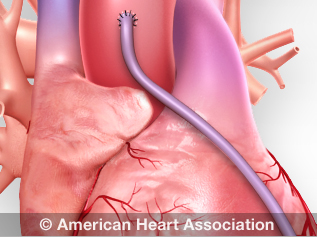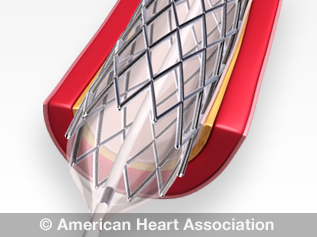Heart Procedures and Surgeries
If you’ve had a heart attack, you likely had some treatments to help you survive and find out what’s wrong. One common treatment is thrombolysis, where doctors inject medication to dissolve clots and restore blood flow. This should be done within 30 minutes of arriving at the hospital for best results. If not done right away, you may need other procedures to improve blood flow to your heart. These may include coronary angioplasty and stenting or coronary artery bypass graft surgery (CABG).
View an illustration of coronary arteries(link opens in new window).
See diagnostic tests and procedures to understand:
- Tests you may have to find out if you had a heart attack
- How much damage was done
- Degree of coronary artery disease (CAD) you have
Coronary Angioplasty
(Also known as percutaneous coronary interventions (PCI), balloon angioplasty and coronary artery angioplasty)
View an animation of angioplasty.
What the procedure does
A special tube with a small balloon is put into the heart’s arteries. The balloon is blown up to open blocked areas where blood flow is reduced or stopped. A stent is often used to keep the artery open and lower the chance of another blockage. This method doesn’t involve open-heart surgery. The procedure takes from 30 minutes to a few hours. It may require an overnight hospital stay.Reason for the procedure
- Greatly increases blood flow through the blocked artery
- Decreases chest pain (angina)
- Increases ability for physical activity that has been limited by angina or ischemia
Medications that may be prescribed post-procedure
Learn more about cardiac medications you may need to take after your procedure to prevent complications and to put you on the best path to recovery.
Download our Answers by Heart sheet: What is Coronary Angioplasty? (PDF)
Laser Angioplasty
What the procedure does
It is like angioplasty, but the catheter has a laser tip that opens the blocked artery. Pulses of laser light destroy the plaque buildup.
Reason for the procedure
- Increases blood flow through blocked arteries
Atherectomy
What the procedure does
It’s like angioplasty but the catheter has a rotating shaver on its tip to cut away plaque from the artery.
Reason for the procedure
- Increases blood flow through the blocked artery by removing plaque buildup
- May also be used in carotid arteries (major arteries of the neck leading to the brain) to remove plaque and reduce the risk of stroke
Bypass Surgery
(Also known as coronary artery bypass graft surgery or CABG (pronounced "cabbage")
View an illustration of coronary bypass(link opens in new window).
What the procedure does
This treatment uses arteries or veins from other parts of your body to go around blocked heart arteries and restore blood flow to your heart. You might need more than one bypass, depending on how many arteries are blocked. This procedure needs several days in the hospital for recovery. View an animation of blood flow(link opens in new window).
Download our Answers by Heart sheet: What is Coronary Artery Bypass Surgery? (PDF)
Reason for the procedure
You may be a candidate for CABG if you have:
- Chest pain (angina)
- Diabetes
- Heart attack due to coronary artery disease
- Multiple blocked coronary arteries
- Heart failure
Medications that may be prescribed post-procedure
Learn more about cardiac medications that you may need to take after your procedure to prevent complications and to put you on the best path for recovery.
Heart Transplant
What the procedure does
A transplant removes a diseased heart and replaces it with a healthy human heart from organ donation.
Reason for the procedure
- Recognized as a proven procedure to restore heart health in select patients
Learn more about heart transplants.
Minimally Invasive Heart Bypass Surgery
(Also known as minimally invasive direct coronary artery bypass, robot-assisted coronary artery bypass or keyhole heart surgery)
What the procedure does
This surgery creates a bypass for blood and oxygen to reach your heart without stopping the heart. The surgeon makes small cuts in the chest to reach your heart. The surgeon locates and prepares an artery on your chest wall to connect to your blocked coronary artery.
Reason for the procedure
- Manages blockage of blood flow to the heart and improves the supply of blood and oxygen to the heart
- Relieves chest pain (angina)
- Reduces risk of heart attack
- Improves ability for physical activity
Stent Placement
What the procedure does
A stent is a wire mesh tube used placed during angioplasty to hold an artery open. The stent stays in the artery forever.
View an animation of a stent(link opens in new window).
Coronary narrowings can form again within stents and are referred to as restenosis.
Reason for the procedure
- Holds the artery open
- Improves blood flow to the heart muscle
- Relieves chest pain (angina)
Medications that may be prescribed post-procedure
Learn more about cardiac medications that you may need to take after your procedure to prevent complications and to put you on the best path for recovery.
Learn more about stents.
Download our Answers by Heart sheet: What is a Stent? (PDF)
Transmyocardial Revascularization (TMR)
What the procedure does
A cut is made on the left breast to reach the heart. A laser makes a series of holes from the outside of the heart into the pumping chamber. Sometimes, TMR is combined with bypass surgery. This needs a cut through the breastbone. TMR usually requires a hospital stay.
Reason for the procedure
- Used to relieve severe chest pain (angina) in very ill people who would not have fully restored blood flow by CABG or angioplasty alone and may be at increased risk of heart attack










